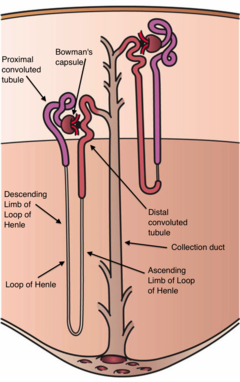Nephron
Nephrons are tiny tubules (miniature tubes) which are the smallest working part of the kidney. This is where the kidney removes waste, excess salt, and excess water.
| Nephron | |
|---|---|
 Diagram (left) of a long juxtamedullary nephron and (right) of a short cortical nephron. The left nephron is labelled with six named nephron segments. Also labelled is the collecting duct, mislabelled the "collection duct"; it is the last part of the nephron. | |
| Details | |
| Precursor | Metanephric blastema (intermediate mesoderm) |
| System | Urinary system |
| Identifiers | |
| Latin | Nephroneum |
| MeSH | D009399 |
| FMA | 17640 |
| Anatomical terminology | |
Each nephron starts in the cortex of the kidney, then goes into the medulla of the kidney, before coming back to the cortex, then goes through the medulla into the pelvis of the kidney. In the pelvis, the nephrons join up with the ureter.[1]
In humans, a normal kidney has between 800,000 and 1.5 million nephrons.[2]
Each nephron consists of a cup-shaped structure at one end called the Bowman's capsule. It extends into a long urinary tubule,that is surrounded by a network of renal capillaries. The urinary tubules of nephrons in each kidney join to form a common tube called the ureter.
Inside the Bowman's capsule is a network of blood capillaries, the glomerulus. The Bowman's capsule and glomerulus together form the Malphigian capsule or Malphigian body.
Liquid passes through the segments of the nephron in this order:
- Bowman's capsule (including glomerulus)
- Proximal convoluted tubule
- Descending loop of Henle
- Ascending loop of Henle
- Distal convoluted tubule
- Collecting duct
References
change- ↑ p160, Biology, Mary Jones and Geoff Jones, 2002 edition, Cambridge University Press, ISBN 0-521-45618-5
- ↑ Guyton, Arthur C.; Hall, John E. (2006). Textbook of Medical Physiology. Philadelphia: Elsevier Saunders. p. 310. ISBN 0-7216-0240-1.
{{cite book}}: CS1 maint: multiple names: authors list (link)